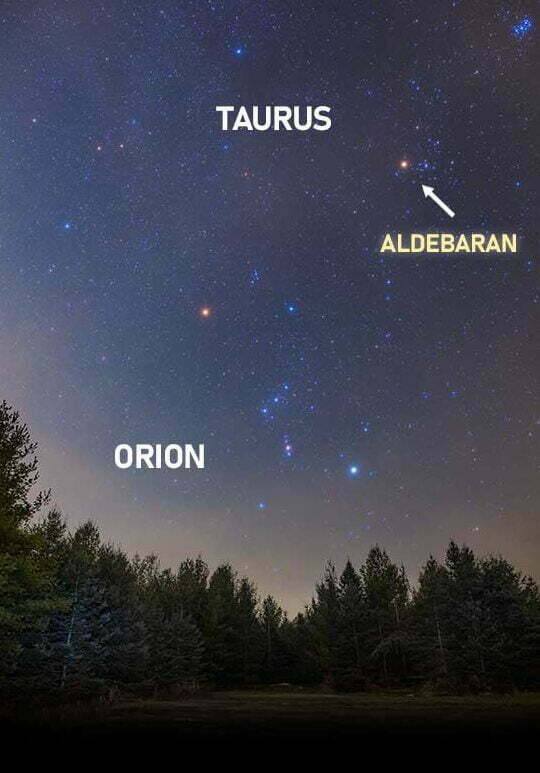Aldebaran has been known to humans since ancient times, with different cultures having various names for it. In Persia, it was referred to as the royal or royal star.
One interesting fact about Aldebaran is that it is a binary star system. The primary star, known as A, is an orange giant and belongs to the spectral class K5 III. The secondary star, known as B, is a dwarf star and belongs to the spectral class M2.
Over time, the giant star has exhausted its hydrogen fuel and has started burning helium, resulting in a significant increase in its size. Scientists predict that in a few billion years, Aldebaran will transform into a white dwarf.
The constellation to which Aldebaran belongs
Indeed, the constellation Aldebaran is part of the Taurus constellation. It serves as the Alpha star in this particular region of the night sky. Additionally, it stands out as one of the most luminous stars within the Zodiac. Some may even argue that it shines brightest throughout the entire celestial sphere.
The name Aldebaran originates from Arabic and translates to “follower.” This designation likely stems from its proximity to the Pleiades star cluster, as it appears to trail behind them in its celestial path.
Alternatively, Aldebaran is frequently referred to as the “Eye of Taurus,” owing to its resemblance to the eyes of a bull.
Furthermore, it is known by other names such as Palilius or Lamparus.
Unusual information
The giant star is over 6.5 billion years old. Scientists have discovered that its radius is 43 times larger than that of the Sun. Additionally, it is 2.5 times more massive than our Sun.
Interestingly, it is also more luminous than our Sun. Specifically, it is 150 times brighter. According to astronomical data, Aldebaran ranks 14th in terms of apparent brightness among stars.
Astronomers have observed that the Moon occasionally eclipses the star Aldebaran. Interestingly, this phenomenon can even be observed during the daytime.
It is possible that there is a large planet in orbit around the star. However, this hypothesis has yet to be proven.
Priests pray to stars. Poets sing to stars. Scientists study the paths, number, and magnitude of stars, making important discoveries.
Vikenty Veresaev. A star
The legend of Aldebaran
Throughout history, space and stars have always been intertwined with mythology. This particular region of the sky is no different.
According to Greek mythology, there once lived a beautiful woman named Europa, the daughter of King Agenor. She caught the attention of Zeus, who decided to woo her by transforming himself into a bull. Europa rode on the bull’s back as he carried her across the sea to the island of Crete. It was there that they had three sons together.
For instance, the African tribes held the belief that Aldebaran, one of the brightest stars, played the role of a skilled hunter. Interestingly, they also regarded him as the spouse of the Pleiades constellation. According to their captivating folklore, the Pleiades instructed Aldebaran to capture a zebra and warned him not to come back empty-handed. Regrettably, Aldebaran embarked on this mission with only a single arrow, which unfortunately missed its mark. As a consequence, the hunter has been relentlessly pursuing his wives ever since, yet he remains hesitant to reunite with them.
Observing the celestial body
Therefore, we have determined the location of Aldebaran within a specific constellation. Additionally, it is important to note that Aldebaran is the most prominent constellation within the zodiac. Consequently, its identification should not pose any significant challenges. Let us now explore the methods for locating this celestial body in the night sky.
Primarily, it is advisable to conduct observations during the winter season. Nonetheless, caution must be exercised due to potential confusion. Specifically, in December, a larger and brighter planet transits through the Taurus constellation. Consequently, Aldebaran is often mistaken for Jupiter.
Secondly, in order to locate the constellation, it is necessary to first locate Orion. Subsequently, extend a straight line from Orion towards the right. Following this trajectory will lead to a radiant point, which is indeed Aldebaran.
Only a few among us have had the opportunity to gaze upon the stars as our ancestors did: the excessive city illumination obscures our view.
Neil Gaiman. Stardust

Aldebaran, a star that shines brightly in the northern hemisphere, is hard to miss when gazing up at the night sky. Throughout history, people from various cultures and nations have attached numerous legends and myths to this celestial body, making it a fascinating subject of observation.

Where is Aldebaran located?
The origin of the name
Description of the appearance

Satellites of Aldebaran


In 1993, a significant discovery was made regarding the radiation emitted by Aldebaran. Long-term fluctuations were observed, indicating the presence of a substellar object located 1.35 AU away from the star. This object could potentially be a brown dwarf or a gas giant, with a mass over 11 times that of Jupiter.
In 2015, scientists announced the detection of another exoplanet within the Aldebaran system. This planet is estimated to be approximately 6.5 times the size of Jupiter and completes a full orbit in around 700 Earth days. It is likely a hot gas giant.
Aldebaran B is the second star in the system and is classified as a faint red dwarf of spectral type M2.
A comparison of star luminosity

The luminosity of stars is a crucial factor that sets them apart. It refers to the amount of radiation that a star emits into space. To illustrate, let’s consider the luminosities of Aldebaran, Regulus, Sirius, and the Sun. Their luminosities are 153L, 288L, 22L, and 1L, respectively. L is the unit of energy released by the Sun, as adopted by astronomers.
When and how to observe
The ideal time to observe the star Aldebaran is during the winter season. Locating the star is relatively simple. You just need to mentally visualize a straight line passing through the three bright stars that make up Orion’s belt, starting from the left and moving towards the right. Following this line, you will find Aldebaran as the first star. There is also a cluster of stars called the Hyades in the constellation of Taurus, which can be observed in the sky. However, their distance from Aldebaran is deceiving. The Hyades are actually located 150 light years away from Earth, which is almost two and a half times farther than Aldebaran. The appearance of the bull’s-eye shape is merely a result of the projection of Aldebaran’s light onto the glow of the Hyades.
Legends and myths

Interesting Trivia

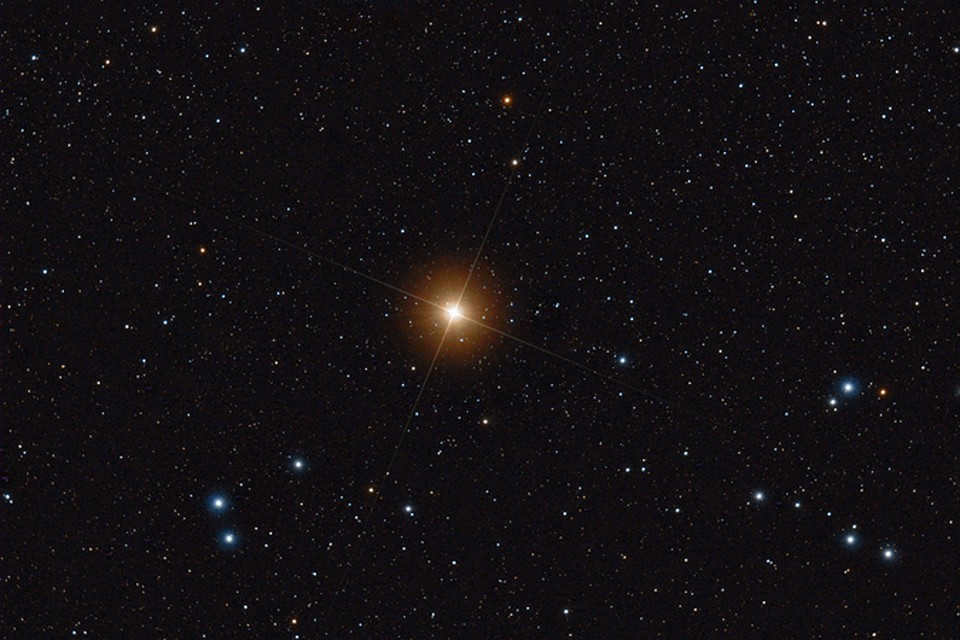
For over 3,000 years, the star Aldebaran has captivated the attention of humans, shining brightly among the countless stars in the night sky. It has been referenced in fantasy literature and featured in various films, making it a celestial object of fascination. Enthusiasts of astronomy are intrigued by all aspects related to this luminous star.
Basic information
Aldebaran is estimated to be billions of years old. Over this vast time period, the star has undergone significant changes, transitioning from a red planet to its current orange color (classified as K5III) as a normal giant. Despite being relatively stable, it does exhibit slight variations in brightness.
These transformations have resulted in an increase in both size and temperature, altering the star’s appearance. According to the latest data, the primary component of Aldebaran’s envelope has expanded to approximately 38 times the diameter of our Sun.
In the future, as helium in the atmosphere becomes depleted, Aldebaran will eventually evolve into a white dwarf. For now, it exists as a supergiant, with a diameter approximately 44 times larger than our Sun.
The planet’s detectability is ascertained by its comparatively close proximity to Earth – a mere 65 light years.
The optical illusion is further supported by the cosmic separations. Aldebaran is twice as near to the star than the Hyades. The distance from Earth to the stellar cluster is approximately 135 light years.
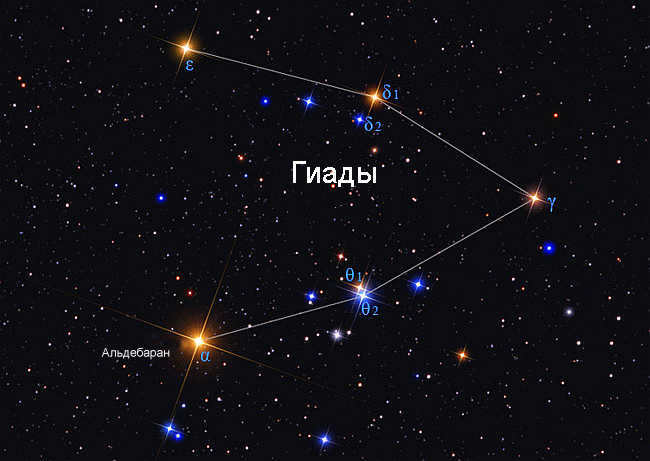
The Origin of the Name
Physical attributes of the celestial body
Providing a detailed account of the celestial body enables scientists to establish its classification in astronomical databases. Based on its spectral classification, the orange giant star is classified as K5 III. A comprehensive summary of the key properties of the star is presented in the table.
Physical properties of α Taurus
| Parameters | Unit. | Indicator (average) |
| Mass of the planet | M☉* | 2.5 |
| Radius | R☉ | 43 |
| Age | billion years | 6.6±2.4 |
| Metallicity** | % | 70 |
| Temperature | K | 3875±3050 |
| Luminosity | L☉ | 150 |
**An extrasystem unit of measurement is used to estimate the parameters of stars relative to the Sun (M, R, L).
**The term “metallicity” refers to the abundance of chemical elements on a planet that are heavier than helium and hydrogen by mass. This measurement is typically expressed as a percentage of the solar metallicity.
Astrometry also takes into consideration the parallax, which is the angle by which the position of an object appears to change relative to the observer’s location. In the case of Aldebaran, the parallax is measured at 50.09 mas (milliseconds) and is used to determine the precise distance to the star. Additionally, the planet has a radial velocity of 53.8 km/s.
Locating Pallilius in the Celestial Sphere
Identifying the constellation to which Pallilius belongs facilitates the process of determining its position in the sky. To begin the search, it is helpful to start from recognizable landmarks. Simply look up at the evening sky and locate the Big Dipper’s Bucket. Since Pallilius is one of the non-circumpolar constellations, it serves as an excellent starting point for the upcoming observation;
The Bucket’s position varies depending on the season. In winter, it can be found in the northeast, while in the fall and summer, it is visible in the north. From there, one can proceed by connecting the outermost stars of the Bucket with a straight line.
To navigate more easily across the sides of the world, you can follow the vector upward until you reach Polaris, the first bright star. Polaris is also known as the Little Bear and is located north of the Big Dipper, which is accompanied by the small dipper in the second constellation.
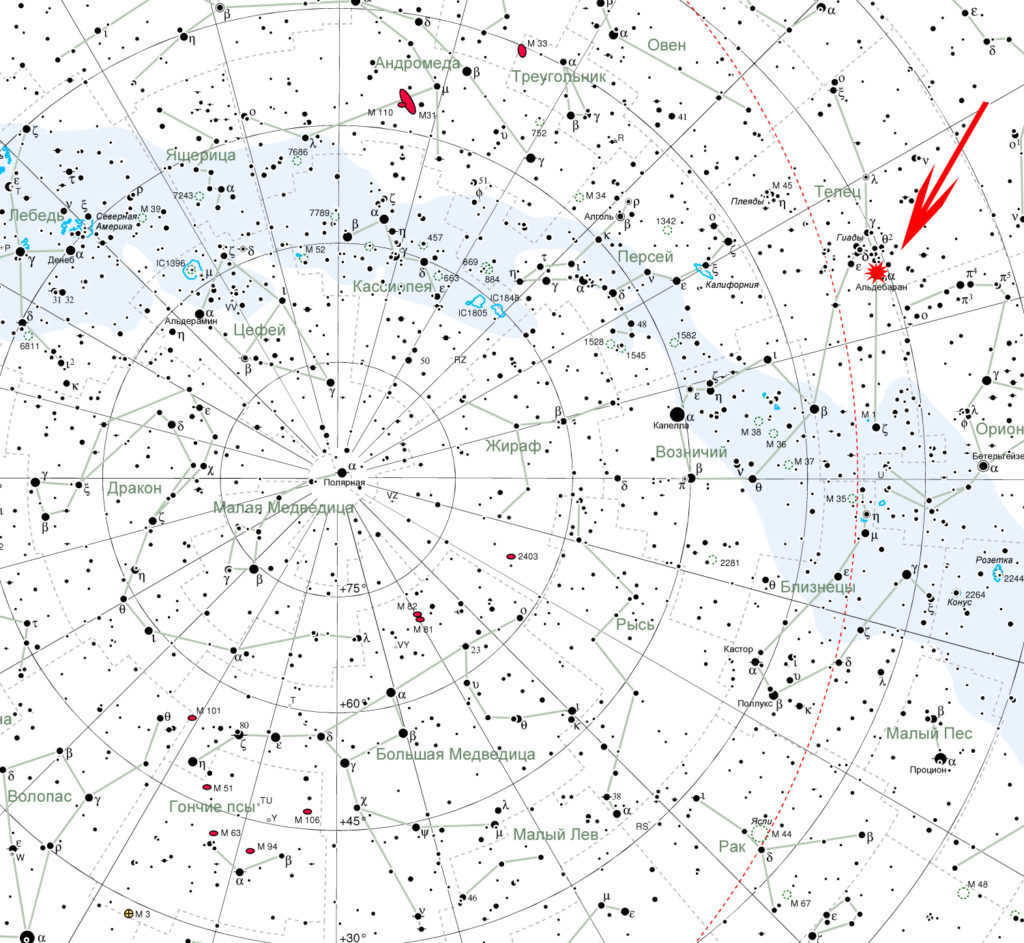
To locate Aldebaran in the night sky, one must wait for the fall-winter season when the constellation Taurus becomes clearly visible in the Northern Hemisphere. The following steps can be taken to find it:
Another useful reference point is the Pleiades, which are sometimes mistaken for the Little Bear’s Dipper. They can be found just above the Taurus constellation. Having a picture of the starry sky can greatly enhance the effectiveness of the search. Additionally, using a star map can be helpful in determining the position of Aldebaran.
Other constellations such as Ascendant, Perseus, Eridanus, Aries, and Gemini can also be used as guides in the search, as they surround the Taurus constellation.
When to observe
The exact position of Alpha Bull can be observed at 04 h 35 m 55.2 s; with a declination of +16°30’33”. However, these coordinates are better understood by experts. In the evening, it is quite noticeable how Orion’s Belt and Aldebaran rise almost simultaneously in the eastern sky.
Appearing in the winter sky shortly after sunset, the star shines brightly throughout the night. By March, Alpha Taurus is already high in the sky when the Sun sets, and it sets below the horizon after midnight.
In the first few days of May, the planet briefly appears in the visible zone, but by the end of the month, it becomes difficult to spot in the sky. It only returns to the field of vision by mid-summer, when it can be observed in the early morning hours.

Since 1989, the Hipparch state satellite has spent more than 3 years in space. Thanks to its research, the distance from Aldebaran to the Sun has been more accurately determined. It has also been discovered that both planets merge into a single visible point once a year (which occurs on June 1).
Ancient treatises mention interesting facts about Alpha Taurus:
The ancient Greeks associated Zeus with the Bull (Taurus). It was in this form that the God of Olympus conquered Europe, captivating it with his gaze. Therefore, in the myths, Aldebaran, the Bull’s Eye, is attributed with magical power.
In the works of the ancient Arabic writer Fizuli, the planet often appears under the name Dəbəran. Many of the plots in Kir Bulychev’s novels take place on Alpha Taurus.
Astrological Significance of Aldebaran
Astrologers attach great importance to the presence of the star Aldebaran within the zodiac belt. Its influence on earthly processes is often likened to that of Jupiter. Additionally, astrologers observe its joint influence alongside Mars and Mercury.
In ancient Roman astrology, four fixed stars were identified and referred to as the Guardians of the sky. Aldebaran guards the eastern gate, while Antares guards the west, Regulus guards the north, and Fomalgaute guards the south.
These stars are considered the angular points in the Horoscope of the spirit, determining the paths of development in both space and time.
Meteorological Impact of Alpha Taurus
Meteorologists have noted that the presence of Alpha Taurus has a significant influence on the Earth’s climate. When Aldebaran aligns with the rising Sun, it is an indication of forthcoming fog, strong winds, and precipitation in the form of rain and thunderstorms.
Furthermore, when Alpha Taurus appears alongside Mars, it stirs up a sense of unrest in nature, often leading to the formation of hurricanes. During the summer season, this celestial combination also brings about intense heatwaves.
Moons of Aldebaran
Astronomers have discovered that Aldebaran, a star in the Taurus constellation, has a satellite known as Aldebaran B. This satellite is a red dwarf belonging to the M2 class. It has an apparent magnitude of 13.6 and an absolute magnitude of 11.98. Aldebaran B is located at a distance of 607 astronomical units from Alpha Taurus.
These findings suggest that the relationship between Aldebaran and its satellite is not merely optical, but rather that they are part of a double star system. It can be compared to objects C and D, which are gravitationally bound together. However, Aldebaran and its satellite only interact visually and are located outside the planet in the Hyades cluster.
Astronomers have reached the conclusion that there is a substellar object present based on the measurements of the radial velocity of three planets (Pollux, Arcturus, and Aldebaran). The long-period oscillations of these planets have been interpreted as evidence of a gas giant orbiting Alpha Taurus. However, there is still no official confirmation of the existence of this brown dwarf.
In 2015, astronomers observed the presence of a hot giant around the primary component, Aldebaran Ab. It is believed that this giant has a mass 6.47 times greater than Jupiter. Additionally, there is a satellite that orbits this exoplanet every 629 days.
A comparison of the brightness of stars
When Alpha Taurus started to burn helium, it expanded in size significantly, which had an impact on its brightness and made it most visible from Earth. In the northern hemisphere of the sky, this star is ranked as the 14th brightest. Aldebaran has an absolute magnitude of only 150 Suns, second only to Alpha Scorpius. Antares surpasses the Sun’s brightness by 4,000 times.
In Orion’s belt, there are other nearby objects that are brighter. Betelgeuse (α) has a brightness equivalent to 80,000 Suns, while Rigel (β) has a brightness equivalent to 45,000 Suns. The largest star is the Goldfish in the Magellanic Cloud. Its absolute brightness surpasses the brightness of the Sun by 600,000 times.
Based on the data provided in the table, α Swan can be identified as the most dominant star. Despite being located at a significant distance from our Solar System, Deneb is comparable to Aldebaran in terms of its apparent stellar magnitude.
When analyzing the stars within the Zodiacal Belt, Alpha Taurus stands out as the brightest star. It is closely followed by Antares (α Scorpio) with a magnitude of 1.09m and Pollux (Gemini) with a magnitude of 1.15m.
Aldebaran is renowned as one of the most brilliant objects in the night sky, visible to the naked eye. This can be attributed not only to its luminosity, but also its position in outer space relative to the prominent Hyades cluster.
Aldebaran, also called the “eye of Taurus”, is an orange giant that is located 65 light years away from Earth.
It is the brightest star in the Taurus constellation and the 14th brightest star in the night sky. Aldebaran has a luminosity that is 518 times greater than that of the Sun.
The name Aldebaran (pronounced /ælˈdɛbərən/) is derived from the Arabic word for “follower”, which is al-dabarān.
With its orange or reddish color, Aldebaran has a stellar classification of K5 III and an apparent magnitude that ranges from 0.75 to 0.95. The star’s variability cannot be observed with the naked eye.
Aldebaran has evolved from the main sequence stage of its life cycle and has depleted the hydrogen fuel in its core. As a result, the star has expanded and now has a size of approximately 44.2 solar radii.
The star has a lower temperature than the Sun, measuring only around 3,700º C, in contrast to the Sun’s 5,500º C.
Finding the star Aldebaran in the sky is a simple task
In order to locate the star in the night sky, observers can easily track the line created by the three stars of Orion’s Belt to the right (in the Northern Hemisphere) or to the left (in the Southern Hemisphere).
Aldebaran can be identified as the first bright star along this line.
The optimal time of year for observing the star Aldebaran is during the autumn and winter seasons, when the star and Orion’s Belt rise in the eastern sky during the evenings and gradually move towards the northwest throughout the night.
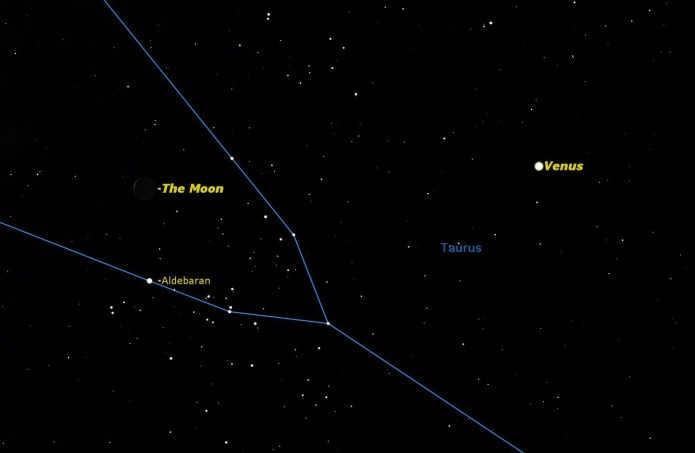
Aldebaran’s stellar arrangement
The system’s arrangement includes a total of five stars. The stars are known as Aldebaran B, Aldebaran C, Aldebaran D, Aldebaran E, and Aldebaran F. The primary star, Aldebaran A, serves as the central star of the system.
Aldebaran B, also referred to as a red dwarf, possesses a stellar classification of M2V. Its apparent magnitudes range from 13.6 to 11.98. It is positioned at a distance of approximately 607 AU from Aldebaran A.
Aldebaran C and D are gravitationally linked and create a binary system. These two stars are situated about 34 AU from each other. They exist far beyond the Aldebaran star system and are part of the Hyades cluster.
Astronomers detected the presence of a companion encircling the star during the 1990s, although subsequent investigations have failed to validate this finding. If indeed present, the satellite possesses a minimum mass equivalent to 11.4 times that of Jupiter. Its orbital period around the star spans 643 days, situated at a distance of approximately 2 astronomical units. The hypothetical satellite, if it exists, would possess a mass lower than 11.4 Jupiter masses.
In several billion years, the star Aldebaran will deplete its supply of helium, subsequently shedding its gaseous envelope and transitioning into a white dwarf.
Roughly 5,000 years ago, Aldebaran served as the marker for the Vernal Equinox Day and the commencement of the Babylonian New Year.

Since ancient times, humans have gazed up at the night sky and identified the brightest celestial bodies, which they grouped together into constellations. In the grand scheme of the Universe, the history of humankind is but a tiny blip, and the images above our heads have remained unchanged since the days when our ancestors believed these stars to be divine entities. If we were to look up at the sky today, we would still see the same radiant dots, but now we possess the knowledge of what they truly are.
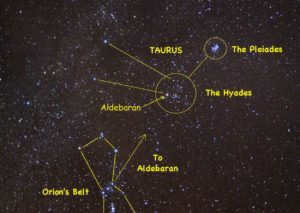
Aldebaran, one of the most brilliant stars in the sky, has captivated scientists and thinkers since ancient times. It has been the subject of legends and has played a prominent role in numerous fantasy works. Today, astronomers are using state-of-the-art technology to study Aldebaran, while an unmanned spacecraft is slowly but surely making its way towards the star, carrying a message from humanity. Let’s delve into the mysteries of Aldebaran and uncover its secrets.
Emerging from the abyss of history.
The celestial body holds significance in the traditions of numerous civilizations, resulting in an array of names. The term commonly employed today originates from the Arabic language. In its literal sense, the name signifies “one who follows.” This designation is derived from the observation that Aldebaran appears to continually trail the Pleiades across the heavens.
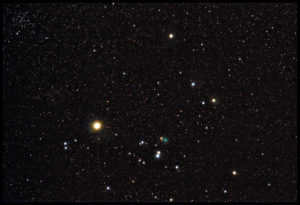
Aldebaran is widely known as the brightest star in the Taurus constellation and is said to represent the eye of a fictional figure. In Latin, it was referred to as Oculus Taurī (the eye of Taurus). During Roman times, Aldebaran was given the name Palilicius, in honor of the god Pales, who was known for protecting shepherds from the uncertainties of life.
The ancient Persians had their own system of categorizing stars, and they identified the brightest ones as “royal” stars. Aldebaran was a part of this esteemed group and was known as Tusketeer. It was believed to bring prosperity to the East.
The belief among the Mexicans was that Aldebaran’s primary purpose was to emit light for the seven Pleiades, which were believed to be constantly giving birth to children.
Modern Times
Today, it is widely known that all of the aforementioned beliefs are merely captivating myths. Nevertheless, reality is just as captivating and captivating as fiction.
According to scientific knowledge, Aldebaran is classified as an orange giant. Its mass is estimated to be no more than 2.5 times that of the Sun (although some sources suggest it could be as low as 1.13 times that of the Sun). However, its radius is a staggering 44 times that of our own star. If Aldebaran were placed at the center of our solar system, it would easily extend beyond the orbit of Mercury. Additionally, this star is 150 times brighter than the Sun.
Despite these fascinating characteristics, Aldebaran appears as nothing more than a tiny speck of light in the night sky due to its distance of 65 light years from Earth.
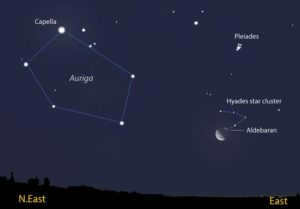
At present, the star has already exhausted its hydrogen resources and is currently undergoing active fusion of helium, which accounts for its remarkable luminosity and impressive dimensions. This stellar narrative is expected to persist for several more billion years, after which the star will undergo the process of shedding its gaseous envelope and ultimately transform into a white dwarf.
How to locate the star Aldebaran
Locating the star Aldebaran can be a bit challenging, as it is one of the brightest stars in the sky. However, with the right knowledge, you can easily find it. Start by identifying Orion’s belt, which consists of three stars in a straight line. Follow the line created by these stars to the right, and the first star that catches your attention will be Aldebaran.
The Brave Pioneer-10
While the term “brave” may not be applicable to technology, there is a sense of admiration for the Pioneer-10 spacecraft as it embarks on its interstellar journey. This unmanned probe was launched in 1972 and has been traveling through vast distances to reach its destination.
Pioneer-10 is a solitary messenger of mankind, venturing into the unknown. Scientists predict that its mission will continue for another two million years, unless it encounters an unforeseen emergency.
What astrologers believe
Aldebaran attracts the attention not only of astronomers but also of astrologers. According to astrologers, this star plays a significant role in people’s lives. It is a potent source of energy that empowers individuals to overcome obstacles, pursue their goals, and conquer great challenges. Aldebaran’s association with Mars, due to its reddish hue, further emphasizes its influence. Therefore, individuals who have Aldebaran in their horoscope must be mindful of their fiery temperament and recognize that not every goal can be achieved through sheer force.
In terms of material wealth, Aldebaran also promises prosperity, but it requires a sensible approach, a clear understanding of one’s objectives, and careful planning.
Aldebaran is the celestial body associated with individuals who possess exceptional physical allure. It embodies an unparalleled force of fascination, consistently captivating attention regardless of the time or place. This phenomenon is not solely confined to superficial aesthetics. Remarkably captivating individuals possess an innate ability to enthrall those in their proximity, even if they initially appear unremarkable.
Whether one chooses to place faith in astrology is a personal decision. However, tonight, make a conscious effort to gaze skyward and marvel at the enchanting brilliance of this remote celestial entity.

Description
Taurus is not just the most starry constellation, it is also incredibly luminous, as an individual without any optical equipment can observe a staggering 216 stars within its boundaries. Moreover, Taurus encompasses nearly 800 square degrees of the celestial sphere.
Where can we find the Taurus constellation? Geographically, the Taurus constellation is situated amidst the Gemini and Aries constellations, and to the northwest of the Orion constellation. Close to the Taurus constellation are also the Perseus, Ascendant, Eriadne, and Cetus constellations. This particular constellation is quite prominent in our moderate latitudes and can be spotted throughout the majority of the year, except for the latter part of spring and early summer.
What is the method for locating the constellation?
The most convenient way to locate the constellation Taurus is by first identifying the more prominent and easily visible constellation Orion, situated slightly below and to the left of the “star Taurus”. Logically, the Taurus constellation will be positioned above and to the right of the Orion constellation. Interestingly, ancient depictions often portray celestial Orion as a hunter poised to strike at celestial Taurus. 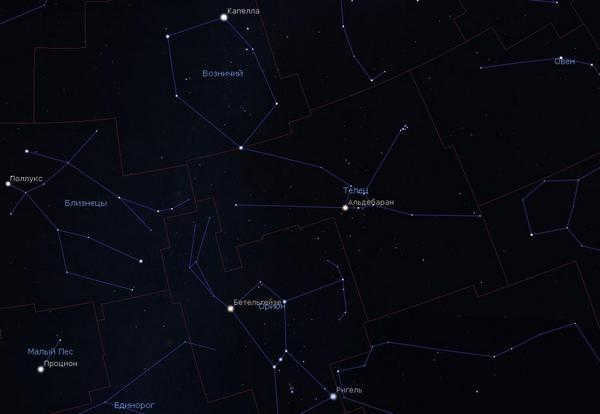 This diagram provides a schematic representation of the Taurus constellation. It is also simple to spot the brightest star in this constellation – Aldebaran, which exhibits a subtle orange tint. As a point of reference, one can utilize the three stars forming Orion’s belt – by drawing an imaginary line through them and extending it to the right, Aldebaran will lie along this path. Furthermore, if one looks further to the right and above Aldebaran, the Pleiades star cluster, a highly visible and captivating feature in the night sky, can be easily observed.
This diagram provides a schematic representation of the Taurus constellation. It is also simple to spot the brightest star in this constellation – Aldebaran, which exhibits a subtle orange tint. As a point of reference, one can utilize the three stars forming Orion’s belt – by drawing an imaginary line through them and extending it to the right, Aldebaran will lie along this path. Furthermore, if one looks further to the right and above Aldebaran, the Pleiades star cluster, a highly visible and captivating feature in the night sky, can be easily observed.  The Pleiades star cluster.
The Pleiades star cluster.
There exists a wide variety of stars within the Taurus constellation and, undoubtedly, we will not provide an account of each one, but we will delve into the most substantial and luminous in great detail.
Aldebaran
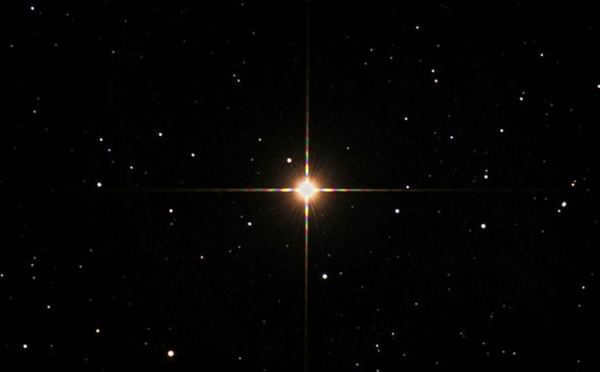
- The luminosity of Aldebaran tends to change in a highly unpredictable manner within a range of 0.2m.
- There is purportedly a massive planet located near Aldebaran that is 11 times larger than our own Jupiter.
- Aldebaran is the largest star that the Moon can pass in its trajectory.
Nath
Nath, also known as beta Taurus, is the second brightest star in the Taurus constellation. It is situated on the border with the Ascendant constellation and was once considered to be a part of both constellations. Nat, or El-Nat as it is sometimes called, is located at a distance twice as far as Aldebaran, specifically 131 light-years away. Furthermore, Nat is moving away from us at a rate of 9 kilometers per second. Nat is approximately 5-6 times larger than our Sun and 4.5 times more massive.
Nath, a blue giant, is experiencing growth similar to Aldebaran and will eventually surpass the alpha star in size and brightness due to its immense proportions. Moreover, Nath possesses the unique characteristic of being a binary star system.

Other unique stars
Within the myriad of stars located in the constellation Taurus, there are two that stand out: theta Taurus – Alcyone and zeta Taurus (which lacks an individual name).
Alcyone is a luminous star situated in the Pleiades cluster, distinguished by its multiple-star system and peculiar structure. At the core of this system lies component A (or Alcyone A), a Ve-type star characterized by its ellipsoidal shape and extraordinarily rapid rotation speed (100 times faster than that of the Sun). Additionally, the system encompasses components B and C – stars of class A0, or in other words, ordinary stars. Lastly, there is also component D (Alcyone D) – a white-yellow dwarf. All four components of Alcyone are observable through a small telescope.
Zeta Taurus, which is located 417 light years away from us and has a star magnitude of 2.97, is remarkable because it emits an astonishing 5700 times more light than our Sun(!) Simply put, it can be described as a stellar super lantern.
The well-known Taurus variable T is worth special attention. It serves as the archetype for an entire category of variable stars. T Taurus is an extremely young star in the process of formation. Studying it will allow astrophysicists to delve deeper into the mysteries surrounding the origin of stars and the unique aspects of their evolution.
“Star Taurus” is well-known for its star clusters, notably the Hyades and Pleiades clusters. Let’s take a closer look at them.
The Hyades cluster
The Hyades cluster is the closest and most scattered cluster to us. Despite being 153 light-years away, it is still twice as far as the star Aldebaran. It is easily identifiable as it appears to contain the brightest star in Taurus, Aldebaran. However, this is merely an illusion, as Aldebaran is actually twice as close to us. Monsieur did not include this cluster in his catalog due to its brightness and wide distribution. At certain times, the Hyades cluster was even considered a distinct constellation.
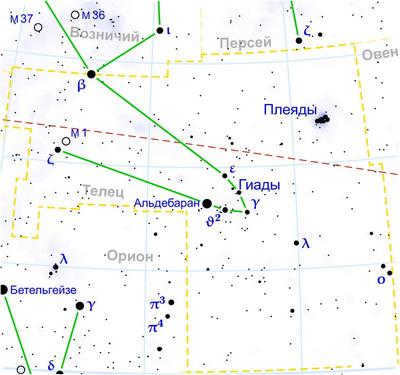
The Taurus constellation is where the Hyades can be found.
Unlike the Pleiades, the Hyades cluster is older and consists of a variety of stars: some are similar to our Sun, while others are red giants, indicating their advanced age.
Additionally, it is noteworthy that the Hyades cluster is gradually moving away from Earth, and in the future, it may become challenging to observe it.
The Pleiades cluster
The Pleiades cluster is a group of seven bright stars that are named after the daughters of the mythical king Atlas and his wife Pleione: Alcyone, Taygeta, Merope, Celaeno, Electra, Atlas, and Pleione (collectively known as the Pleiades). According to Greek mythology, when the Pleiades were attacked by Orion, the god Zeus placed them in the sky. However, Orion, who is already a constellation, continues to watch over them.
The Pleiades can be found to the right of Aldebaran and have a distinctive shape that resembles a bucket. This makes them relatively easy to locate in the night sky, even without the use of a telescope.
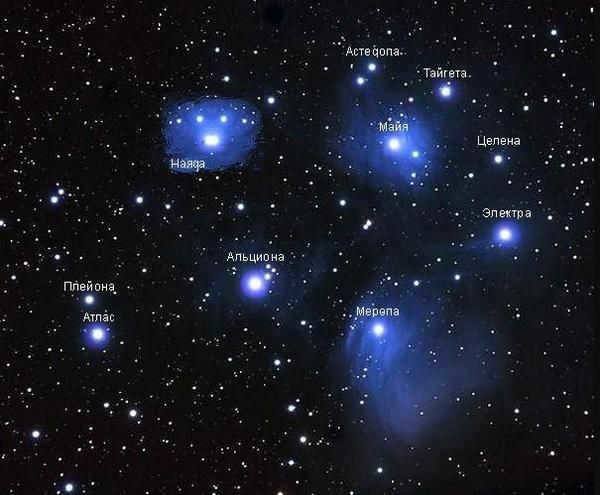
The primary stars of the Pleiades cluster.
All the principal stars of this cluster are hot white giants with strong luminosity, but alongside them, there are numerous other stars that are not as bright. Among them are hypothetical twins of our Sun, as well as white giants. Interestingly, stars the size of the Sun in the Pleiades cluster can only be observed through a telescope. However, red giants are absent here because, as we are aware, red giants are stars of a “mature, elderly” age, while “stellar younglings” dominate in this cluster.
The Crab Nebula
The Crab Nebula is an intriguing and extraordinary entity located in the constellation of Taurus. It holds a significant place in the Monsieur catalog as the very first object listed. In fact, the creation of this catalog was inspired by the presence of the Crab Nebula. This awe-inspiring phenomenon originated from a massive supernova explosion, which was witnessed by medieval Arab and Chinese astronomers in the year 1054. However, it is important to note that the actual explosion occurred 6500 years prior, and it was only in 1054 that its light finally reached Earth.
What remains of the Crab Nebula is a colossal cloud formed by the remnants of a supergiant star that underwent collapse and subsequent explosion. This cloud spans an impressive distance of 11 light years, and astonishingly, it continues to expand at a staggering rate of 1500 kilometers per second.
In 1968, a pulsar was discovered in the heart of the Crab Nebula. This pulsar, which is a neutron star measuring approximately 30 km in diameter and having a mass 2.5 times that of the Sun, rotates at a rate of 30 revolutions per second. The observations of this pulsar offer numerous valuable insights to astronomers.

This is the visual representation of the Crab Nebula.
To observe this celestial object, one must utilize binoculars or a telescope. It is worth noting that the Crab Nebula’s shape has been undergoing changes over the course of several decades due to its rapid expansion.
In our previous article, we highlighted only the most fascinating entities within the Taurus constellation.
Recommended reading and helpful resources
- Allen, Richard Hinckley. Star names: their lore and significance. – revised edition. – Dover Publications, 1963. – p. 383. – ISBN 978-0-486-21079-7.
- Chartrand, Mark R. Skyguide: A Handbook for Amateur Astronomers. – Golden Books Publishing Company, 1983. – ISBN 0-307-13667-1.
- Levy, David H. Deep Sky Objects. – Prometheus Books, 2005. – ISBN 978-1-59102-361-6.
- O'Meara, Stephen James. Deep-sky companions: exploring the hidden depths. – Cambridge University Press, 2011. – ISBN 978-0-521-19876-9.
- Ridpath, Ian; Tirion, Wil. Monthly sky guide. – 6th edition. – Cambridge University Press, 2003. – ISBN 978-0-521-53306-5.
Video
can be paraphrased as
Visual Content
or
Moving Images
.
Byline: Pavel Chaika, chief editor of Poznavaika magazine
During the process of composing this article, my objective was to ensure its utmost uniqueness, usefulness, and quality. I would greatly appreciate any feedback or constructive criticism in the form of comments on the article. Please feel free to reach out to me with any queries, suggestions, or requests via email at pavelchaika19[email protected] or through Facebook. Thank you for your attention and best regards, the author.
Aldebaran, a red giant star, has a lower temperature of 3900 K compared to the Sun. However, its radius is approximately 44 times that of the Sun, making it over 400 times more luminous. It has a slow rotation, taking 520 days to complete a full revolution.
The Pioneer 10 spacecraft is currently headed in the general direction of Aldebaran and is expected to reach it in approximately two million years.
- 1 Nomenclature
- 2 Observation
- 3 Observation history
- 4 Physical characteristics
- 5 Visual satellites
- 6 Planetary system
- 7 Etymology and mythology
- 7.1 Mythology
- 7.2 Names in other languages
- 7.3 In modern culture
Classification
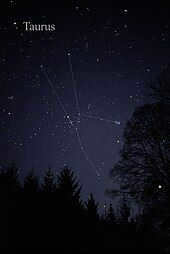
Aldebaran, situated at the center of the Taurus constellation, shines as the most brilliant star in the sky.
The star’s traditional name, Aldebaran, is derived from the Arabic term al Dabarān (“الدبران”), which translates to “follower” due to its apparent tracking of the Pleiades. In 2016, the Working Group on Star Names (WGSN) of the International Astronomical Union officially recognized Aldebaran as the star’s proper name.
Aldebaran, also known as Alpha Tauri, is the most luminous star in the Taurus constellation. It is designated as the 87th star in the constellation of 7th magnitude or brighter, based on its direct ascension. Additionally, it is identified by its Flemstid 87 Taurus designation, as well as the catalog numbers 1457 (Bright Star Catalog), HD 29139, and Hipparcos 21421 (commonly referenced in scientific publications).
While Aldebaran is a variable star, it is not assigned a separate variable star designation and is instead listed using its Bayer designation.
Aldebaran and a few neighboring stars are listed in various double star catalogs, such as the Washington Double Star Catalog as WDS 04359 + 1631 and the Aitken Double Star Catalog as ADS 3321. It was listed as a companion double star in the eleventh catalog, known as H IV 66 in the Herschel Double Star Catalog and Σ II 2 in the Struve Double Star Catalog. Additionally, it is included alongside a 14th magnitude star known as β 550 in the Burnham Double Star Catalog.
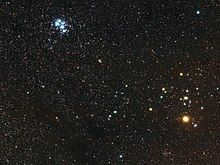
Aldebaran is a star located in the Hyades, which is a prominent asterism in the night sky. It is easily recognizable due to its brightness and its proximity to the three stars of Orion’s belt. If you follow these three stars in the opposite direction of Sirius, you will come across Aldebaran.
Interestingly, Aldebaran appears to be the brightest member of the scattered cluster that forms the bull’s head-shaped asterism. However, this is because the star happens to fall in a line between Earth and the Hyades. In reality, the cluster itself is actually more than twice as far away, approximately 150 light-years distant.
Aldebaran, located 5.47 degrees south of the ecliptic, can occasionally be hidden by the Moon. These occurrences happen when the Moon’s ascending node aligns with the fall equinox. A sequence of 49 instances took place between January 29, 2015, and September 3, 2018. Each event was observable from regions in the northern hemisphere or near the equator. Unfortunately, individuals in Australia or South Africa will never have the opportunity to witness the Aldebaran eclipse due to its position too far south of the ecliptic. On September 22, 1978, during an eclipse, a fairly accurate estimation of Aldebaran’s diameter was obtained. Aldebaran aligns with the Sun around June 1 each year.
History of Observation
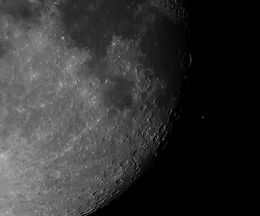
During the lunar eclipse of Aldebaran on March 11, 509 AD in Athens, Greece, English astronomer Edmund Halley made an interesting observation. He noticed that Aldebaran had changed its position since that time, moving a few angular minutes further north. This discovery, along with observations of the shifting positions of stars like Sirius and Arcturus, led to the realization that Aldebaran had its own motion. Modern observations show that Aldebaran has shifted 7 feet in the last 2000 years, which is about a quarter of the diameter of the full moon. This movement is attributed to the precession of the equinoxes. Interestingly, 5000 years ago, the spring equinox in the Northern Hemisphere was in close proximity to Aldebaran.
In 1864, William Huggins conducted the first studies of Aldebaran’s spectrum at his private observatory in Tulse Hill, England. During his research, he was able to identify lines of various elements, including iron, sodium, calcium, and magnesium.
In 1886, Edward S. Pickering from the Harvard College Observatory used a photographic plate to document fifty absorption lines in Aldebaran’s spectrum. These findings were later included in the Draper Catalog, which was published in 1890.
By 1887, advancements in photographic technology allowed for the measurement of a star’s radial velocity through the analysis of the Doppler shift in its spectrum. Using this method, astronomers estimated that Aldebaran had a falling speed of approximately 30 miles per second (48 km/s). These calculations were based on measurements conducted at the Potsdam Observatory by Hermann C. Vogel and his assistant Julius Scheiner.
Aldebaran was observed in 1921 using an interferometer attached to the Hooker telescope at Mount Wilson Observatory, in order to determine its angular diameter. However, these observations did not result in its resolution.
Due to its rich history of observation, Aldebaran was selected as one of the 33 stars to serve as landmarks for the Gaia mission, which aims to calibrate stellar parameters. It was also previously utilized to calibrate instruments on board the Hubble Space Telescope.
Physical attributes
Comparing the sizes of Aldebaran and the Sun
Aldebaran is officially recognized as the spectral standard for stars of the K5 + III classification. Its spectrum reveals that it is a giant star that has evolved from the main-sequence region of the Hertzsprung-Russell diagram after depleting its hydrogen supply. The collapse of the star’s core into a degenerate helium core caused a hydrogen shell to ignite outside the core, placing Aldebaran on the red giant branch (RGB).
Aldebaran’s photosphere has an effective temperature of 3910 K. It possesses a surface gravity of 1.59 cgs, which is typical for a giant star, but approximately 25 times less than that of Earth and 700 times less than that of the Sun. Its metallicity is approximately 30% lower than that of the Sun.
According to data from the Hipparcos satellite and other sources, Aldebaran is located approximately 65.3 light-years (20.0 parsecs) away. By studying the oscillations of the star, scientists have determined that it is around 16% more massive than the Sun. However, its luminosity is much higher, with a whopping 518 times that of our Sun, due to its larger radius. Numerous measurements have been taken to determine Aldebaran’s angular diameter. The value currently used as part of the Gaia reference calibration is 20.580 ± 0.030 milliarcseconds. This measurement corresponds to a diameter that is 44 times larger than that of the Sun, equivalent to approximately 61 million kilometers.
Aldebaran is a star that belongs to the LB type of slow irregular variable stars. According to the General Catalog of Variable Stars, historical reports indicate fluctuations in its apparent magnitude, ranging from 0.75 to 0.95. However, more recent studies have shown smaller variations, with some even suggesting almost no change. Based on Hipparcos photometry data, the amplitude of Aldebaran’s variability is estimated to be only about 0.02 stellar magnitude, with a potential period of approximately 18 days. Ground-based photometry conducted with high precision revealed variations of up to 0.03 stellar magnitude and a possible period of around 91 days. Nevertheless, when analyzing observations over a much longer time span, it becomes evident that the overall amplitude is likely to be less than 0.1 stellar magnitude, indicating irregular changes in Aldebaran’s brightness.
The extended molecular outer atmosphere (MOLsphere) of Aldebaran exists beyond its chromosphere, where gas molecules can form due to low temperatures. This outer region has a radius approximately 2.5 times that of the star and maintains a temperature of approximately 1500 K. Analysis of the spectrum reveals the presence of carbon oxide, water, and titanium oxide. As the stellar wind expands beyond the MOLsphere, it eventually encounters the compaction jump and merges with the hot ionized interstellar medium, which dominates the Local Bubble. This interaction gives rise to an astrosphere with a roughly spherical shape and a radius of approximately 1000 a.u., centered on Aldebaran.
Optical Satellites
A cluster of five faint stars can be observed in close proximity to Aldebaran in the celestial sphere. These binary star constituents have been assigned uppercase Latin letters in the approximate order of their discovery, with the initial letter A being reserved for the primary star. Certain attributes of these constituents, such as their spatial orientation with respect to Aldebaran, are succinctly summarized in the tabular format.
| 13.60 | 31.60 | 113 | 2007 | 47.3417 ± 0.1055 |
| 11.30 | 129.50 | 32 | 2011 | 19.1267 ± 0.4274 |
| 13.70 | — | |||
| 12.00 | 36.10 | 323 | 2000 | |
| 13.60 | 255.70 | 121 | 2000 | 0.1626 ± 0.0369 |
According to various studies, including Gaia Data Release 2, it has been suggested that Alpha Taurus B and Aldebaran have similar proper motion and parallax, indicating that they may be a physical binary system. However, due to the close proximity of the dim B component to the bright host star, it is challenging to make accurate measurements, and there is a significant margin of error that prevents conclusive establishment or dismissal of a physical connection between the two. Currently, there is no definitive evidence linking the B component or any other entity to Aldebaran. The spectral type M2.5 has been assigned to Alpha Taurus B.
CD Alpha Taurus is a binary system where the components C and D stars are gravitationally linked and revolve around each other in a shared orbit. Situated far beyond Aldebaran, these stars belong to the Hyades star cluster and share the same orbital path. Similar to the rest of the cluster’s stars, they do not have any physical interaction with Aldebaran.
Planetary system
In 1993, the radial velocity measurements of Aldebaran, Arcturus, and Pollux indicated that Aldebaran displays periodic changes in radial velocity, which could be interpreted as the presence of a substellar companion. The measurements for Aldebaran suggested the existence of a companion with a minimum mass of 11.4 times that of Jupiter, orbiting at a distance of 2.0 a.u. (300 Gm) in a slightly eccentric orbit with a period of 643 days. However, similar variations were observed in all three stars studied, leading the authors to conclude that these fluctuations were likely intrinsic to the stars themselves and not caused by the gravitational influence of a companion.

Observing the night sky from the perspective of Aldebaran, one can see the Big Dipper shining brightly. In 2015, a study provided stable long-term evidence of both a planetary companion and stellar activity. Through astroseismic analysis, it was determined that Aldebaran b has a minimum mass of 5.8 ± 0.7 Jupiter masses. Additionally, when the star was on the main sequence, it emitted light levels similar to that of Earth, suggesting a potentially habitable temperature. This would have placed Aldebaran b, along with any of its moons, within the habitable zone.
Aldebaran, which was originally known as نير الضبران (Nā᾽ir al Dabarān in Arabic), had the meaning of “the brightest of the follower”. The term al Dabarān (الدبران) was then applied to the whole lunar mansion that included the Hyades. It is believed that it followed the Pleiades. Over time, various transliterated spellings have been employed, with the current Aldebaran emerging as the accepted norm in recent times.
Mythology
This star, which is easily visible and bright in its suggestive constellation, has been a popular subject of ancient and modern myths.
- Mexican Culture: According to the Seri people of northwestern Mexico, this star provides light for seven women who are in labor (Pleiades). It is known by three names: Hant Caalajc Ipápjö, Queeto, and Azoj Yeen oo Caap (“the star that goes before”). The lunar month corresponding to October is called Queeto yaao “the way of Aldebaran”.
- Aboriginal culture: In the Clarence River region of northeastern New South Wales, this star is believed to be the ancestor of Carambal, who stole another man’s wife. The woman’s husband tracked him down and burned the tree in which he was hiding. It is believed that he ascended into the sky as smoke and became the star Aldebaran.
Names in other languages
- In the Hindu astronomical tradition, he is known as Rohini, which translates to “red” and is one of the twenty-seven daughters of Daksha. Rohini is also the wife of the god Chandra, who represents the Moon.
- In Ancient Greek, this celestial body was called Lampadias, which can be translated as “torch-like” or “bearer”.
- In Chinese, it is referred to as 宿 (Bì Xiù), which means “Network”. This name specifically denotes the asterism that includes Aldebaran, ε Taurus, δ Taurus, γ Taurus, 71 Taurus, and λ Taurus. Consequently, Aldebaran itself is known as 畢 宿 五 (Bì Xiù wǔ), which translates to “Fifth Star of the Net”.
In modern society.

The Italian frigate Aldebaran (F590) has taken on the name Aldebaran or Alpha Tauri, which has been used in various contexts.
Examples of its use include:
- The Aldebaran Rock in Antarctica
- The US Navy vessel USS Aldebaran (AF-10) and the Italian frigate Aldebaran (F 590)
- The proposed Aldebaran microsatellite launch vehicle
- The French company Aldebaran Robotics
- The fashion brand AlphaTauri
- The Formula 1 team Scuderia AlphaTauri, formerly known as Toro Rosso
This star is also featured in works of fiction such as Away from the Madding Crowd and Down and Out in Paris and London. It is frequently depicted in science fiction, including the Lensman series and Fallen Dragon. Due to its status as the brightest star in the Zodiac constellation, it holds significant importance in astrology.

